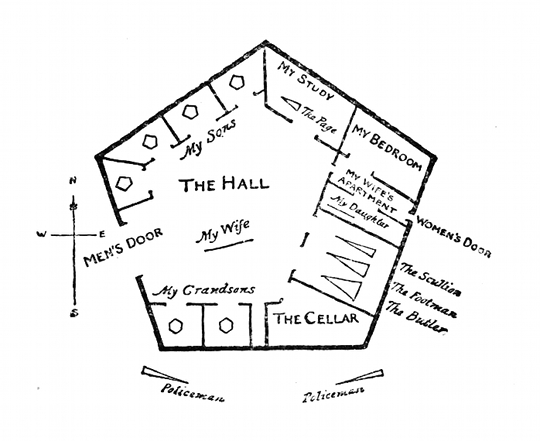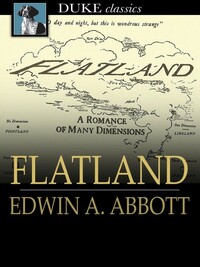Take a photo of a barcode or cover
Flatland is pretty much ingrained in the cultural consciousness at this point. Somehow, however, I had not only failed to read it but knew only of the second part of it - in which a 2D being travels into the third dimension and sees his world from above.
But it turns out that the whole is more than this tangential slice.
Flatland spends about half of its run-length indulging in world-building. Initially it starts out a little slow but stick with it. Residing in a 2D plane means that objects appear to its inhabitants as straight lines and A^2 painstakingly explains the perils and complications of that. He also explains with diagrams how to distinguish one polygon from another. The section ends with the telling of an uprising that answers the question: but why don't they use colours to differentiate each other?
The second part is equally imteresting but more familiar. A square travels to Lineland and a sphere pulls the square out of Flatland into Spaceland. And then everyone tries to explain dimensions beyond their comprehension to eachother. They even briefly visit Pointland!
Taken at face value the content described above is a fun mental exercise in spatial geometry but I've of course neglected the societal structure and Flatland's attitudes towards social class and, notably, women. Following Chapter 4, Concerning the Women, I felt so deflated that I had to go check A^2 wasn't just a blatant misogynist. At the advice of some goodreads buddies I rented the annotated version of the eBook - very cool that we can rent books now - and discovered that scholars believe that A^2 was parodying the Victorian's obsession with Ancient Greek society, whilst neglecting its uglier aspects such as rampant classism, slavery, and of course misogyny.
I'd highly recommend at least getting the annotated edition (this one: [b:The Annotated Flatland: A Romance of Many Dimensions|2855811|The Annotated Flatland A Romance of Many Dimensions|Edwin A. Abbott|https://i.gr-assets.com/images/S/compressed.photo.goodreads.com/books/1390090280l/2855811._SX50_.jpg|4243538]) as a companion to the main text. It puts a lot of choices into context.
Recommended!

But it turns out that the whole is more than this tangential slice.
Flatland spends about half of its run-length indulging in world-building. Initially it starts out a little slow but stick with it. Residing in a 2D plane means that objects appear to its inhabitants as straight lines and A^2 painstakingly explains the perils and complications of that. He also explains with diagrams how to distinguish one polygon from another. The section ends with the telling of an uprising that answers the question: but why don't they use colours to differentiate each other?
The second part is equally imteresting but more familiar. A square travels to Lineland and a sphere pulls the square out of Flatland into Spaceland. And then everyone tries to explain dimensions beyond their comprehension to eachother. They even briefly visit Pointland!
Taken at face value the content described above is a fun mental exercise in spatial geometry but I've of course neglected the societal structure and Flatland's attitudes towards social class and, notably, women. Following Chapter 4, Concerning the Women, I felt so deflated that I had to go check A^2 wasn't just a blatant misogynist. At the advice of some goodreads buddies I rented the annotated version of the eBook - very cool that we can rent books now - and discovered that scholars believe that A^2 was parodying the Victorian's obsession with Ancient Greek society, whilst neglecting its uglier aspects such as rampant classism, slavery, and of course misogyny.
I'd highly recommend at least getting the annotated edition (this one: [b:The Annotated Flatland: A Romance of Many Dimensions|2855811|The Annotated Flatland A Romance of Many Dimensions|Edwin A. Abbott|https://i.gr-assets.com/images/S/compressed.photo.goodreads.com/books/1390090280l/2855811._SX50_.jpg|4243538]) as a companion to the main text. It puts a lot of choices into context.
Recommended!

Una historia sencilla que implica un ejercicio mental importante. El nivel de concentración en ciertos momentos para poder imaginar lo que nos está contando el protagonista es demandante, pero se agradece como algo muy diferente a lo que uno está acostumbrado.
I read the first few pages 15 years ago, but finally decided to look it up on audible after listening to the three body problem. I think I liked it better than three body problem. The first part is a slightly misogynistic look by the standards over 140 years after it was originally written, but it's not Abbott's fault that flatlanders are so 2 dimensional, just like it's not the squares fault the king of the 1 dimensional world was so terrible.
Read this in high school for Geometry class. Interesting.
informative
slow-paced
Plot or Character Driven:
N/A
Strong character development:
No
Loveable characters:
Complicated
Diverse cast of characters:
Complicated
Flaws of characters a main focus:
Yes
Ursula K Le Guin would have loved this anthropologist Square.
A Square gets visited by the ghosts of dimensions 0,1 and 3. Very funny and creative way to explain dimensions. Laughed throughout. Quick read.
inspiring
reflective
fast-paced
Plot or Character Driven:
Plot
Strong character development:
Yes
Loveable characters:
Complicated
Diverse cast of characters:
N/A
Flaws of characters a main focus:
N/A
I regret not finishing this book last year. What appears to be a novel about mathematics and physics touches upon so many philosophical debates. Also it's unbelievable how Abbott could have written this before Einstein. Only downside is that at times it's very difficult to distinguish the sexism from the satire but I'm inclined to believe (most of) the book is the latter.
Maybe I will get back to it someday, but I simply couldn’t invest enough mental energy to make it interesting.
It is what it says on the box.
This was a highly enjoyable and memorable read that can best be summed up as a “curiosity”. It’s very enjoyable to explore the concepts of 2D living, and have that become an exploration of thought on the fourth dimension, but I think the story fails to combine them in a satisfactory manner. Splitting the book into 2 parts makes sense, but the first half is much less interesting (to me at least) than the second. Cohesion is the word which aptly describes what it lacks.
Also, it’s very classist and sexist, and I am here for it.
This was a highly enjoyable and memorable read that can best be summed up as a “curiosity”. It’s very enjoyable to explore the concepts of 2D living, and have that become an exploration of thought on the fourth dimension, but I think the story fails to combine them in a satisfactory manner. Splitting the book into 2 parts makes sense, but the first half is much less interesting (to me at least) than the second. Cohesion is the word which aptly describes what it lacks.
Also, it’s very classist and sexist, and I am here for it.





